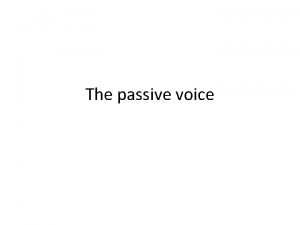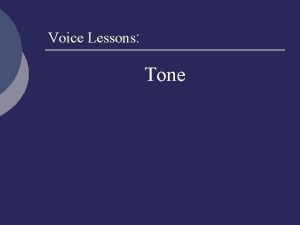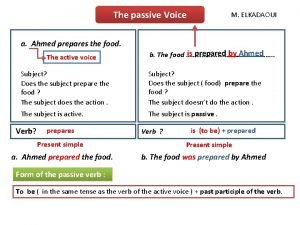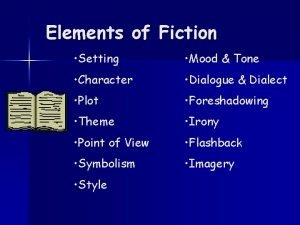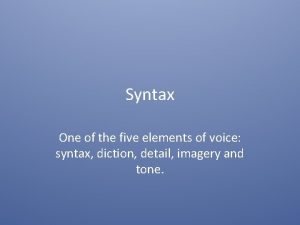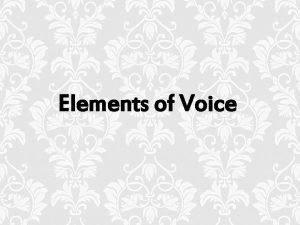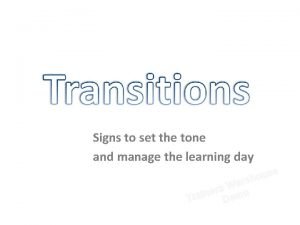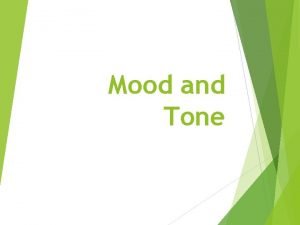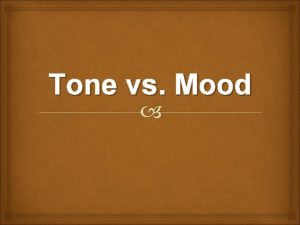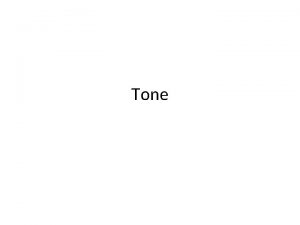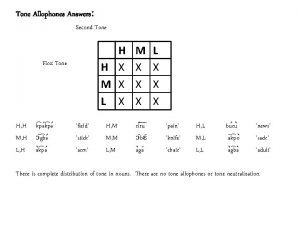ELEMENTS OF VOICE TONE Elements of Voice Tone































- Slides: 31

ELEMENTS OF VOICE: TONE

Elements of Voice: Tone What is Tone? Tone is the expression of the author’s or speaker’s attitude toward the subject or toward the audience.

Elements of Voice: Tone What is tone? More specifically, tone is the means the author’s attitude is communicated to his audience.

Elements of Voice: Tone How does a writer conve y tone? Convey Tone through these techniques: Diction Detail Imagery Figurative Language Syntax

Elements of Voice: Tone How is this important for the AP English Language and Compositio n Exam? On the AP Language exam, the words “tone” and “attitude” are used almost synonymously. So, consider tone and attitude as the same thing – the author or speaker’s feelings about the subject or audience.

Elements of Voice: Tone How is this important for the AP English Language and Composition Exam? On the AP exam, you may be asked to identify an author’s tone and to discuss how he conveys that tone in a particular text. This is a two-part task: identify and analyze.

Elements of Voice: Tone How do I identify and analyze tone? Two types of tone: oral written

Elements of Voice: Tone What is oral tone? Every time you speak, your words convey a tone to your listener. Oral tone involves the way your voice sounds, not just the meaning of the words themselves. Facial expression, gestures, and body positions also contribute to the tone your words convey.

Elements of Voice: Tone What is Oral Tone? Consider this situation: You are frantically studying for a physics test that is crucial to your grade for the semester. The tone your simple words, “I’ll be there in a minute, ” would likely vary greatly as a response to these interruptions:

Elements of Voice: Tone What is Oral Tone? Your mother calls you and tells you to take out the garbage immediately. When you answer her, your tone might be “exasperated” or “frustrated. ”

Elements of Voice: Tone What is Oral Tone? Your little brother asks you for the fourth time to help him with a model he is building. Your tone might be “irritated” or perhaps “angry. ”

Elements of Voice: Tone What is Oral tone? Your girlfriend, an “A” student in physics, calls you on the phone, says she has ordered your favorite pizza, and asks if you want to come to her house and study for the test. Your tone might be quite “agreeable, ” or perhaps even “enthusiastic. ”

Elements of Voice: Tone Identifying Oral Tone Stop now and apply your knowledge: Oral Tone Group Practice.

Elements of Voice: Tone How do I identify Written Tone? The difference between oral and written tone is that the author must use words alone to convey his attitude.

Elements of Voice: Tone How do I identify Written Tone? Tone is an element of all verbal communication, whether oral or written. Even a statement such as “Resident Parking” has a tone: straightforward, matter-of-fact, informative.

Elements of Voice: Tone How do I identify Written Tone? Even slight changes can affect the tone conveyed. “Resident Parking Only” sounds a bit sterner, and a non-resident may sense that he is being not only informed, but warned.

Elements of Voice: Tone How do I identify Written Tone? If the word “only” is underlined or an explanation mark is added, the tone becomes more emphatic. If such a small alteration can affect the perceived tone of a simple parking sign, imagine how important an author’s choices are in determining the tone he conveys to a reader.

Elements of Voice: Tone How do I actually analyze tone? Tips to help you analyze tone: Begin by highlighting important sounding words or words which seem to evoke a response or add to the overall effect. After reading – look back at the highlighted words – often, these reveal the tone.

Elements of Voice: Tone Recognizin g Tone Work through the Recognizing Tone handout (from Collier’s Magazine) In the early 1950 s, Senator Joseph Mc. Carthy had claimed that various publications that criticized him were involved in Communism. Advertisers began to pull their ads from these publications:

Elements of Voice: Tone How do I go about ientifying a writer’s tone? Recognizing Tone First, recognize the choices the author has made, particularly word choice (diction) and phrasing (syntax). Vivid imagery and figurative language can also help convey the writer’s attitude. Be sure to pay attention to the notes on Degrees of Intensity and Complementary and Contrasting Tones.

Elements of Voice: Tone How do I identify tone? Read through the handout

Elements of Voice: Tone Follow up repsones In groups of 3, discuss the following questions: Did you learn anything new? If so, how will you use that knowledge to help you determine tone? Do you have any questions or concerns that were not addressed in this practice? If so, can your group members help give you a better understanding?

Elements of Voice: Tone Assignment: For Homework for tonight, read the two excerpts from John F. Kennedy’s Inaugural Address and Louisa May Alcott’s “Death of a Soldier. ”

Elements of Voice: Tone Tips for homework Remember to highlight words which seem important or evoke a response. Decide which two tones these words suggest. Then write two complementary tone words on the blanks. Complementary tones are similar but not exactly the same. After you have determined tone, write two sentences – one for each ton. Underline the word or words that help establish this tone. These sentences are not about the passage; they are independent thoughts.

Elements of Voice: Tone How do I write about tone? Writing about Tone Now that you have practiced recognizing and identifying an author’s tone, it’s time to move to analyzing tone. You will be writing analysis paragraphs in response to prompts about an author’s use of tone in a given passage. Later, we will write complete essays comprised of analysis paragraphs as required on the AP Language

Elements of Voice: Tone How do I write about tone? Here are the steps. The first step to writing your analysis paragraph is to identify the tone(s) the author is conveying in the passage. Ideally, you will identify two tones which may be either complementary or contrasting.

Elements of Voice: Tone How do I write about tone? Here are the steps. Writing about tone: Next, you will determine the author’s purpose in the passage; determine what the author wants the reader to understand. These two elements – the author’s tone and the author’s purpose – will lead into your topic sentence.

Elements of Voice: Tone How doe I write about tone? Writing about tone: Once you have established the author’s tone and purpose, you will write your topic sentence, an assertion in response to the prompt you are given. Follow this sentence with two or three major points, each of which will present an idea or example from the passage supporting your assertion.

Elements of Voice: Tone How do I write about tone? Writing about tone: Each major point will then be followed by two to four elaborating sentences, which may contain quotes from the passage. Finally, you will write a concluding sentence that satisfactorily concludes the paragraph, stressing the paragraph’s mail idea.

Elements of Voice: Tone How do I write about tone? Writing about tone: For the prompts we will write on during this unit, you will be asked to discuss how an author’s use of tone produces a certain effect in a passage. Your topic sentence and major points will relate to the author’s use of one or more tones.

Elements of Voice: Tone How do I write about tone? Writing about tone: In your elaborations, you will provide examples of these tones and examples of how they achieve their intended effect. Use the example from the handouts on Senator Margaret Chase Smith’s “Declaration of Conscience”
 Falling intonation
Falling intonation Formal style
Formal style Formal and informal writing examples
Formal and informal writing examples You must wash that shirt for tonight’s party
You must wash that shirt for tonight’s party Speaker's tone
Speaker's tone Voice lessons: tone answers
Voice lessons: tone answers Voice lessons tone answers
Voice lessons tone answers Passive voice vs active voice
Passive voice vs active voice Passive voice machine
Passive voice machine Present continuous passive
Present continuous passive Passive patterns
Passive patterns What is voice in grammar
What is voice in grammar Causative
Causative Repetition sentence examples
Repetition sentence examples What is tone in fiction
What is tone in fiction Imagery elements of poetry
Imagery elements of poetry Tone literary elements
Tone literary elements Formal elements tone
Formal elements tone Literary elements tone
Literary elements tone 5 elements of voice
5 elements of voice Diction vs detail
Diction vs detail 7 elements
7 elements Molecular element
Molecular element Http //elements.wlonk.com/elements table.htm
Http //elements.wlonk.com/elements table.htm Technical elements of drama
Technical elements of drama Where is the setting of the folktale?
Where is the setting of the folktale? Overhead allocation
Overhead allocation Folktale tone
Folktale tone Tongue-in-cheek examples
Tongue-in-cheek examples Tone signs
Tone signs Tone of beowulf
Tone of beowulf Value tone
Value tone



